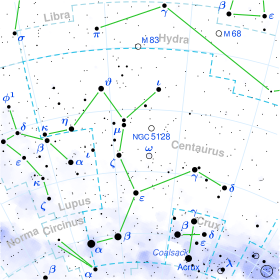Phi Centauri, Latinized from φ Centauri, is a blue-white hued star in the southern constellation Centaurus. It is visible to the naked eye with an apparent visual magnitude of +3.7.[2] The annual parallax shift is 6.21 mas[1] as measured from Earth, which yields a distance estimate of around 530 light years. It is moving further from the Sun with a radial velocity of +5 km/s.[5]
| Observation data Epoch J2000.0 Equinox J2000.0 | |
|---|---|
| Constellation | Centaurus |
| Right ascension | 13h 58m 16.27s[1] |
| Declination | −42° 06′ 02.7″[1] |
| Apparent magnitude (V) | +3.745[2] |
| Characteristics | |
| Spectral type | B2 IV[3] |
| U−B color index | −0.851[4] |
| B−V color index | −0.222[4] |
| Astrometry | |
| Radial velocity (Rv) | +5.3±1.5[5] km/s |
| Proper motion (μ) | RA: −22.77±0.15[1] mas/yr Dec.: −20.13±0.12[1] mas/yr |
| Parallax (π) | 6.21 ± 0.17 mas[1] |
| Distance | 530 ± 10 ly (161 ± 4 pc) |
| Absolute magnitude (MV) | −2.20[2] |
| Details | |
| Mass | 8.5±0.3[3] M☉ |
| Radius | 4.19±0.35[6] R☉ |
| Luminosity | 4,000[7] L☉ |
| Surface gravity (log g) | 4.08±0.07[6] cgs |
| Temperature | 21,638±388[6] K |
| Rotational velocity (v sin i) | 79[8] km/s |
| Age | 18.0±3.2[3] Myr |
| Other designations | |
| Database references | |
| SIMBAD | data |
This is a B-type subgiant star with a stellar classification of B2 IV.[3] It has no known companions, but does show radial velocity variations and higher order pulsations in the spectrum.[9] The star is just 18[3] million years old with 8.5[3] times the mass of the Sun and has 4.2[6] times the Sun's radius. It is radiating around 4,000[7] times the Sun's luminosity from its photosphere at an effective temperature of about 21,638 K.[6]
This star is a proper motion member of the Upper Centaurus–Lupus sub-group in the Scorpius–Centaurus OB association, the nearest such co-moving association of massive stars to the Sun.[7]
References
edit- ^ a b c d e f van Leeuwen, F. (2007), "Validation of the new Hipparcos reduction", Astronomy and Astrophysics, 474 (2): 653–664, arXiv:0708.1752, Bibcode:2007A&A...474..653V, doi:10.1051/0004-6361:20078357, S2CID 18759600. Vizier catalog entry
- ^ a b c Anderson, E.; Francis, Ch. (2012), "XHIP: An extended hipparcos compilation", Astronomy Letters, 38 (5): 331, arXiv:1108.4971, Bibcode:2012AstL...38..331A, doi:10.1134/S1063773712050015, S2CID 119257644.
- ^ a b c d e f Tetzlaff, N.; et al. (January 2011), "A catalogue of young runaway Hipparcos stars within 3 kpc from the Sun", Monthly Notices of the Royal Astronomical Society, 410 (1): 190–200, arXiv:1007.4883, Bibcode:2011MNRAS.410..190T, doi:10.1111/j.1365-2966.2010.17434.x, S2CID 118629873.
- ^ a b Gutierrez-Moreno, Adelina; Moreno, Hugo (June 1968), "A photometric investigation of the Scorpio-Centaurus association", Astrophysical Journal Supplement, 15: 459, Bibcode:1968ApJS...15..459G, doi:10.1086/190168.
- ^ a b Gontcharov, G. A. (November 2006), "Pulkovo Compilation of Radial Velocities for 35495 Hipparcos stars in a common system", Astronomy Letters, 32 (11): 759–771, arXiv:1606.08053, Bibcode:2006AstL...32..759G, doi:10.1134/S1063773706110065, S2CID 119231169.
- ^ a b c d e Fitzpatrick, E. L.; Massa, D. (March 2005), "Determining the Physical Properties of the B Stars. II. Calibration of Synthetic Photometry", The Astronomical Journal, 129 (3): 1642–1662, arXiv:astro-ph/0412542, Bibcode:2005AJ....129.1642F, doi:10.1086/427855, S2CID 119512018.
- ^ a b c de Geus, E. J.; et al. (June 1989), "Physical parameters of stars in the Scorpio-Centaurus OB association", Astronomy and Astrophysics, 216 (1–2): 44–61, Bibcode:1989A&A...216...44D.
- ^ Wolff, S. C.; et al. (2007), "Rotational Velocities for B0-B3 Stars in Seven Young Clusters: Further Study of the Relationship between Rotation Speed and Density in Star-Forming Regions", The Astronomical Journal, 133 (3): 1092–1103, arXiv:astro-ph/0702133, Bibcode:2007AJ....133.1092W, doi:10.1086/511002, S2CID 119074863.
- ^ Alecian, E.; et al. (July 2014), "Discovery of new magnetic early-B stars within the MiMeS HARPSpol survey", Astronomy & Astrophysics, 567: 19, arXiv:1404.5508, Bibcode:2014A&A...567A..28A, doi:10.1051/0004-6361/201323286, S2CID 119161720, A28.
